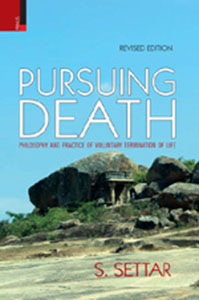
Pursuing Death: Philosophy and Practice of Voluntary Termination of Life (Revised Edition)
AUTHOR – S. Settar
| HB ₹1395 . $ 84.95 . ₤ 56.95 |
e-Book ₹ 1245 . $ 76.95 . ₤ 49.95 |
|
INFORMATION
- AUTHOR : S. Settar
- HB ISBN : 978-93-80607-43-6
- EBOOK ISBN : 978-93-84092-56-6
- Year : 2017
- Extent : 326 pp.
- Discount available on checkout
- Usually dispatched within 3 to 5 working days.
Pursuing Death
| HB ₹ 1395 . $ . ₤ |
PB ₹ . $ . ₤ |
|
| POD ₹ . $ . ₤ |
e-Book ₹ . $ . ₤ |
INFORMATION
- AUTHOR -S. Settar
- ISBN – 978-93-80607-43-6
- Year – 2017
- Extent: 400 + 40 coloured illustrations
- 10% discount + free shipping
- Usually dispatched within 3 to 5 working days.
Pursuing Death widens the canvas of enquiry on the Jaina practices of voluntary termination of life, identified with terms such as Santara, Sallekhana, Samadhi, Sanyasana, Aradhana, Bhaktapratyakhyana, Panchapada, Prayopagamana, Ingini, etc. This volume undertakes an in-depth study of both the philosophy and the practice of death, as revealed in a wide variety of texts written in Prakrit, Sanskrit, Kannada as well as a vast body of historical records, dated between the third century BCE and nineteenth century CE.
The citation for the National Award of the Indian History Congress, conferred on this volume at the Fifty-fourth Annual Session (1993), states, ‘Pursuing Death by Professor S. Settar presents the theory and practice of voluntary termination of life in historical perspective, it illumines the problems with the help of Jaina philosophical writings, historical archaeology, art history and socioeconomic history.The methodology is new and a whole new area has been opened up in Indian historical studies.’
The Author
S. Settar is Emeritus Professor at the National Institute of Advanced Studies (NIAS), Indian Institute of Science Campus, Bangalore. He has earlier held the chairs of Prof. S. Radhakrishnan (NIAS, Bangalore), Indian Council of Historical Research (New Delhi) and Department of History and Archaeology (Karnatak University, Dharwad); and Directorships of Indian Institute of Art History, and the Indira Gandhi Centre for the Arts (Southern Region, Bangalore).
Professor Settar has to his credit 30 books on history, art history, archaeology, religion and philosophy, classical language and linguistics, and epigraphy, published in Europe and India. He is a bilingual (Kannada and English) writer. His internationally acclaimed works are Inviting Death (1989); Hoysala Sculptures in the National Museum, Copenhagen (1975); Memorial Stones (1982, co-edited with Günther D. Sontheimer); The Hoysala Temples, 2 vols. (1992); Somanathapura (2012); and Hampi: A Medieval Metropolis (1990).
Pursuing Death widens the canvas of enquiry on the Jaina practices of voluntary termination of life, identified with terms such as Santara, Sallekhana, Samadhi, Sanyasana, Aradhana, Bhaktapratyakhyana, Panchapada, Prayopagamana, Ingini, etc. This volume undertakes an in-depth study of both the philosophy and the practice of death, as revealed in a wide variety of texts written in Prakrit, Sanskrit, Kannada as well as a vast body of historical records, dated between the third century BCE and nineteenth century CE.
The citation for the National Award of the Indian History Congress, conferred on this volume at the Fifty-fourth Annual Session (1993), states, ‘Pursuing Death by Professor S. Settar presents the theory and practice of voluntary termination of life in historical perspective, it illumines the problems with the help of Jaina philosophical writings, historical archaeology, art history and socioeconomic history.The methodology is new and a whole new area has been opened up in Indian historical studies.’
The Author
S. Settar is Emeritus Professor at the National Institute of Advanced Studies (NIAS), Indian Institute of Science Campus, Bangalore. He has earlier held the chairs of Prof. S. Radhakrishnan (NIAS, Bangalore), Indian Council of Historical Research (New Delhi) and Department of History and Archaeology (Karnatak University, Dharwad); and Directorships of Indian Institute of Art History, and the Indira Gandhi Centre for the Arts (Southern Region, Bangalore).
Professor Settar has to his credit 30 books on history, art history, archaeology, religion and philosophy, classical language and linguistics, and epigraphy, published in Europe and India. He is a bilingual (Kannada and English) writer. His internationally acclaimed works are Inviting Death (1989); Hoysala Sculptures in the National Museum, Copenhagen (1975); Memorial Stones (1982, co-edited with Günther D. Sontheimer); The Hoysala Temples, 2 vols. (1992); Somanathapura (2012); and Hampi: A Medieval Metropolis (1990).
Table of Contents
Table of Contents
| Abbreviations | vii-viii |
| List Of Illustrations | ix-xii |
| Preface To The Revised Edition | xiii |
| Preface To The First Edition | xv-xvi |
| Foreword | xvii-xviii |
| PART I WHY PURSUE DEATH?:A PHILOSOPHY OF PURSUIT | |
| 1. Introduction Liberation Of Self |
3-19 |
| PART II THE PRESCRIBED PATH: WISE MAN’S PURSUIT | |
| 2. Bhaktapratyakhyana Fast Unto Death: Preliminary Preparations |
23-37 |
| 3. Bhaktapratyakhyana Fast Unto Death: Final Course |
38-64 |
| 4. Ingini Death After Realizing The Nature Of The Soul |
65-72 |
| 5. Prayopagamana Death By Denying Self-Help |
73-86 |
| PART III FRUITFUL DEATHS | |
| 6. Samadhi Meditation Unto Death |
89-122 |
| 7. Pancapada Chanting TheHymns Of Salvation |
123-141 |
| 8. Sallekhana Scratching Out Body To Save Soul |
142-166 |
| 9. Aradhana Death After Attaining Wisdom: Meaning, Variety, Purpose |
167-184 |
| 10. Sanyasana Death After Shedding External And Internal Bondages |
185-221 |
| 11. Nisidhi Meaning And Significance |
222-237 |
| Glossary | 239-274 |
| Bibliography | 275-281 |
| Index | 283-308 |





